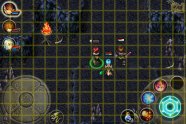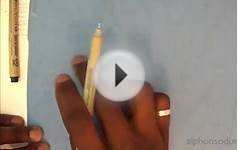What you see here is a . A triangle strip is a series of connected triangles, 2 triangles in our case.
OpenGL draws the following triangle strip (which is a square) using the vertices in the following order:
Triangle 1: V1 -> V2 -> V3
Triangle 2: V3 -> V2 -> V4
It draws the first triangle using the vertices in order, then it takes the last vertex from the previous triangle and uses the last side of the triangle as the basis for the new triangle.
This also has benefits: we eliminate redundant data from the memory.
Grab the from the previous article and create a new class called Square.
If you compare the Square class with the Triangle class, you will notice just one difference:
package net.obviam.opengl; import java.nio.ByteBuffer; import java.nio.ByteOrder; import java.nio.FloatBuffer; import javax.microedition.khronos.opengles.GL10; public class Square { private FloatBuffer vertexBuffer; // buffer holding the vertices private float vertices[] = { -1.0f, -1.0f, 0.0f, // V1 - bottom left -1.0f, 1.0f, 0.0f, // V2 - top left 1.0f, -1.0f, 0.0f, // V3 - bottom right 1.0f, 1.0f, 0.0f // V4 - top right }; public Square { // a float has 4 bytes so we allocate for each coordinate 4 bytes ByteBuffer vertexByteBuffer = ByteBuffer.allocateDirect(vertices.length * 4); vertexByteBuffer.order(ByteOrder.nativeOrder); // allocates the memory from the byte buffer vertexBuffer = vertexByteBuffer.asFloatBuffer; // fill the vertexBuffer with the vertices vertexBuffer.put(vertices); // set the cursor position to the beginning of the buffer vertexBuffer.position(0); } /** The draw method for the square with the GL context */ public void draw(GL10 gl) { gl.glEnableClientState(GL10.GL_VERTEX_ARRAY); // set the colour for the square gl.glColor4f(0.0f, 1.0f, 0.0f, 0.5f); // Point to our vertex buffer gl.glVertexPointer(3, GL10.GL_FLOAT, 0, vertexBuffer); // Draw the vertices as triangle strip gl.glDrawArrays(GL10.GL_TRIANGLE_STRIP, 0, vertices.length / 3); //Disable the client state before leaving gl.glDisableClientState(GL10.GL_VERTEX_ARRAY); } }
The difference is in the highlighted lines (13-18). That’s right, we’ve added one more vertex to the vertices array.











